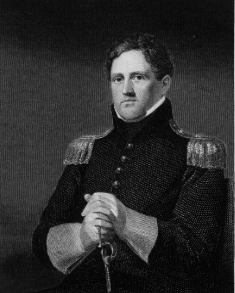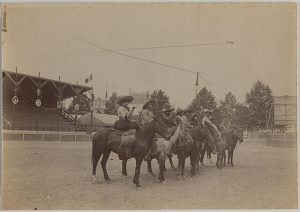A fan of ornate uniforms, supporter of strict military regulations, and a common partaker in quarrels with superiors, General Winfield Scott earned the name “Old Fuss and Feathers.” But General Winfield Scott was not just a hothead who liked pomp and circumstance. He was a great American general—one of the generals responsible for the American victory in the Mexican-American War (1846-1847). And it is important to note that General Scott’s grandiose demeanor was not always so. He was born into a modest family in Petersburg, Virginia in 1786. It was not until his marriage to Maria Mayo that he began his climb the social ladder. Mayo was a part of an elite family from Richmond, Virginia, where her father was a slaveholder, owner of three houses, and owner of a toll bridge across the James River. After his marriage to Mayo, Scott joined the military in 1808, beginning a fifty-three-year career in the military. Just two years into his military career, he was court-martialed and put on a twelve-month suspension for disrespecting one of his superior officers. However, he made good use of his time.1 In that twelve-month suspension from the military, Winfield Scott studied military history and strategy. By doing this, he laid a solid foundation for what was yet to become his future military career as a general. Once back in the military, the high-point of his career happened during the Mexican-American War, where he led outnumbered American troops to victory against the Mexican army.2
The Mexican-American War occurred for various reasons. Some of the reasons for the start of the war include the annexation of Texas in 1845, dispute over the Texas border (whether the border would be the Nueces River or the Rio Grande), and President Polk’s westward expansionist interests, primarily concerning the acquisition of California.3

Even though General Scott proved to be a great general in the Mexican-American War, that did not mean that he necessarily supported the war. He often referred to the war as “Mr. Polk’s War,”4 and he delicately tried to state his opinion about the matter: “Hostilities with Mexico, might, perhaps have been avoided; but Texas lay between—or rather in the scale of war.” Despite his reservations towards the war, he still led one of the most successful campaigns. Scott’s opinion about his own campaign was that “…[it was] executed with impartial rigor, gave the highest moral deportment, and discipline ever known in an invading army.”5
Originally, President Polk’s strategy for the war was to defend Texas and to strike an attack on the Northern frontier of Mexico, which would be led by General Zachary Taylor. General Taylor found himself in a stalemate situation, and that is when Polk sent General Scott to summit an attack starting at the port of Veracruz, which would continue inward to Mexico City. In March of 1847, General Winfield Scott invaded Veracruz. Upon their arrival to Veracruz, Scott stated, “…we did not doubt meeting at our landing the most formidable struggle of the war. No precaution therefore was neglected.”6 The Siege at Veracruz lasted for twelve days until the Mexicans surrendered. After the siege, Scott continued to push westward towards Mexico City.7

One of General Scott’s most impressive battles of the campaign was the Battle of Cerro Gordo. At about sixty-five miles northwest of Veracruz with about 8,500 men, General Scott reached the mountain pass of Cerro Gordo where his forces were up against 12,000 Mexican troops under the command of General Santa Anna, who was sure that General Scott and his men would not be able to pass them while they had the positional advantage. While Cerro Gordo stood at about one-thousand feet, there was a lower hill next to it called La Atalaya, which General Santa Anna deemed to be impassable due to its steep ravines. After being ordered to scout out the terrain, Captain Robert E. Lee and his men found a small pathway up La Atalaya that would allow for an attack on the Mexican troops using a flanking maneuver. It was now planned that the men would attack the Mexican troops from the side using the peak of La Atalaya and from the front, head-on, as well. Because General Santa Anna left La Atalaya unprotected, the American troops were successful.8
The brigade ascended the long and difficult slope of Cerro Gordo, without shelter, and under the tremendous fire of artillery and musketry with the utmost steadiness, reached the breastworks, drove the enemy from them, planted the colors of the 1st artillery, 3d and 7th infantry—the enemy’s flag still flying—and, after some minutes’ sharp firing, finished the conquest with the bayonet.9.
At the Battle of Cerro Gordo, the Mexican troops lost 1,131 men and 3,000 others were taken as prisoners. On the American side, there were 431 casualties.10 After The Battle of Cerro Gordo, General Scott led his troops to victory in other battles including the Battle of Contreras, the Battle of Churubusco, and the Battle of Chapultepec before his arrival in Mexico City. After three days of intense fighting, General Scott captured Mexico City on September 14, 1847. The Treaty of Guadalupe Hidalgo marked the end of the Mexican-American War on February 2, 1848. From this, Mexico agreed to the cession of Arizona, New Mexico, Utah, Colorado, California, Nevada, and Texas (with the border at the Rio Grande and not at the Nueces River). The United States gained all of this for $15,000,000.11

General Winfield Scott, while a brilliant general, owed much of the success he had in the Mexican-American War to his lieutenants. Some of his lieutenants included Robert E. Lee, George B. McClellan, P.G.T Beauregard, and Ulysses S. Grant. 135 of Scott’s men would become generals in their later military careers, 78 of those fighting for the Union forces and 57 fighting for the Confederate forces in the Civil War. The same men that helped each other in the Mexican-American War went on to fight against each other in the American Civil War only 15 years later.4
By 1861, the beginning of the American Civil War, General Scott was 75 years old and he was seen as too old to command the Union forces in the field. General George B. McClellan, who fought with General Scott’s troops during the Mexican-American War in a lower rank, would lead the Union troops instead. Still, Scott would try to help the troops in the Civil War strategically by promoting the so-called Anaconda Plan. His idea was to blockade the Southern ports along the Atlantic and Gulf Coast to strangle the South economically. But this plan required time, and many people did not see the Civil War as lasting that long, and so General Scott’s plan was ridiculed. The Union instead decided to fight the Civil War head-on, which led to the First Battle of Manassas on July 21, 1861. Ironically, after realizing the war would last longer than expected, the wisdom of Scott’s Anaconda Plan became understood, as Lincoln was eager to win the war.13 The American Civil War would not end for another four years, in 1865, with 620,000 deaths.14 There is telling whether General Scott’s plan might have cut the number of casualties down had it been implemented from the beginning of the war.
Scott died on March 29, 1866 in West Point, New York. Before his death, he published a memoir to preserve all the great accomplishments he made as a general in the Mexican-American War and indirectly in the American Civil War.
In December of 1861, President Abraham Lincoln presented General Winfield Scott to the Two Houses of Congress, saying words still relevant today:
During his long life the nation has not been unmindful of his merits; yet in calling to mind how faithfully and ably and brilliantly he has served his country, from a time far back in our history, when few now living had been born, and thenceforward continually—I cannot but think we are still his debtors.15
- Winfield Scott, Memoirs of Lieut.-General Winfield Scott, edited by Timothy D. Johnson (Knoxville: University of Tennessee Press, 2015), xvi. ↵
- Winfield Scott, Memoirs of Lieut.-General Winfield Scott, edited by Timothy D. Johnson (Knoxville: University of Tennessee Press, 2015), xvii. ↵
- Alan Brinkley, American History: Connecting with the Past Volume 1 to 1865 (New York: McGraw-Hill Education, 2011), 357-358. ↵
- Winfield Scott, Memoirs of Lieut.-General Winfield Scott, edited by Timothy D. Johnson (Knoxville: University of Tennessee Press, 2015), xviii. ↵
- Winfield Scott, Memoirs of Lieut.-General Winfield Scott, edited by Timothy D. Johnson (Knoxville: University of Tennessee Press, 2015), 206. ↵
- Winfield Scott, Memoirs of Lieut.-General Winfield Scott, edited by Timothy D. Johnson (Knoxville: University of Tennessee Press, 2015), 210. ↵
- New Encyclopedia, s.v. “Mexican American War.” ↵
- Ulysses S. Grant, “March to Jalapa—Battle of Cerro Gordo—Perote—Puebla—Scott and Taylor,” Personal Memoirs, http://www.latinamericanstudies.org/cerro-gordo/cerro-gordo-grant.htm (accessed December 3, 2016). ↵
- General Winfield Scott, at Plan del Rio, Mexico, to William L. Marcy, Secretary of War, at Washington, D.C. Dispatch communicating Scott’s official report of the Battle of Cerro Gordo (April 19, 1847) ↵
- Encyclopedia Britanica, s.v. “Battle of Cerro Gordo.” ↵
- National Archives, “The Treaty of Guadalupe” https://www.archives.gov/education/lessons/guadalupe-hidalgo (accessed December 3, 2016). ↵
- Winfield Scott, Memoirs of Lieut.-General Winfield Scott, edited by Timothy D. Johnson (Knoxville: University of Tennessee Press, 2015), xviii. ↵
- Encyclopedia Virginia, s.v. “Anaconda Plan,” by Brendan Wolfe. ↵
- National Park Service, “Civil War: Facts,” https://www.nps.gov/civilwar/facts.htm (accessed December 3, 2016). ↵
- Winfield Scott, Memoirs of Lieut.-General Winfield Scott, edited by Timothy D. Johnson (Knoxville: University of Tennessee Press, 2015), 317. ↵



23 comments
Alyssa Valdez
Very interesting! I thought this article was very well put together. I was not familiar with General Scott so reading this article was very intriguing. I think it’s funny how someone who was nicknamed “Old fuss and Feathers,” would be such a big part of history. I was more fascinated by his part and involvement in the Mexican-American war along with his lieutenants.
Cameron Mays
This article covered all bases on General Scott’s lifetime, providing adequate insight to his contributions, which made it a worthwhile read. One thing I wish was slighting different however: Whenever discussing broader events, like the war itself, that information should be weaved together better with Scott’s life, so readers don’t get confused on what the article is covering. Other than that, I didn’t have many problems. Nice article.
Alexis Soto
As a Mexican national who grew up in the United States this article caught my interest. Your article was well presented and I managed to learn new information about Winfield Scott and his role in the American Military. It was interesting to note how not all Americans sought to fight a war with Mexico. It was also interesting to see how his career began. One would never had thought that arguably one of the greatest American Generals was suspended in the beginning of his career. This was a great read and I thoroughly enjoyed it.
Justin Sassman
It was interesting to find that the great general Scoot had such a rough start in his military career especially seeing how magnificent he was in taking down a superior force in Cerro Gord. That being said the battle at Cerro Gordo, the was that the Mexican army was defeated reminds of how the 300 Spartans were, through a mountain pass with little or no defense. another interesting aspect was how the opinion of slavery and succession from the union divide many of his lieutenants, this was a pretty good and information article.
Samuel Sanchez
It was a good article very interesting. Never knew much on General Scott. I liked how you gave all this information about him from his early life to his military years. He achieved a lot during his military years and I liked how you included all the battles that he contributed in. It was amazing how in his older years his Anaconda Plan could have been the solution to decreasing the time and causalities the Civil War caused. He truly was a great general.
Cameron Adelman
Overall an outstanding article on the career of General Scott. I especially liked how you ended with Lincoln’s quote; it gave the conclusion a definitive “end” that these sort of articles sometimes lack.
Two minor pieces of feedback:
Your first quote feels a little random. It’s definitely relevant and definitely a good inclusion, but a short introduction to the quote would have helped established its context for the reader (similar to how you did your second quote).
Second, you have a minor typographical error in the third-to-last paragraph. The last sentence should begin with “There is no telling…”
Other than those small things, it was a great read. Well done.
Sam Vandenbrink
Very good informative article on General Winfield, teaching me a bunch of ways that he lead his armies into battle where everything was looking against them but still prevailed to win the battles. He was an inspiration for allot of the younger generals going into the civil war. The article itself was very well organized leaving me with great information of General Winfield and his accomplishments.
Mario Sosa
I have never heard of General Winfield Scott, but upon reading this article, I became fascinated at how one man managed to lead armies in both the mexican-american war and the civil war. I was also unaware of how many of General Scott’s men would later be fighting each other during the civil war. Very informative and nicely structured. Superb!
Nicolas McKay
Before this article I probably would never have guessed that anyone name “Old Fuss and Feathers” could have such a large impact on History. Few people have have played such a role in two monumental eras in American history. As someone who has recently been researching the Mexican American war, it was incredible to find out how much helped win the war, while opposing it at the same time.
Priscilla Reyes
Very informative article on the life of the American general, Winfield Scott. I love that you included his words, which really show the type of leader he was, definitely someone to look up to. It is interesting how even though he fought in the war, he didn’t really agree with it, but saw it as inevitable. I believe his view on Polk and the war might of been affected by studies during his suspension from the military.